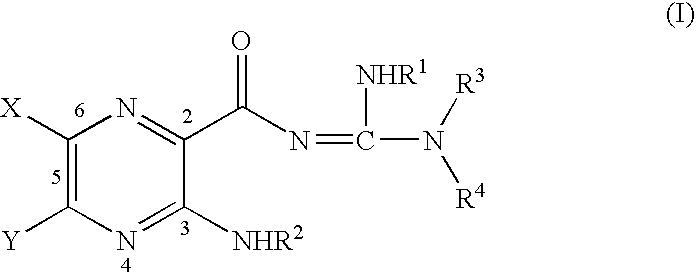Capped pyrazinoylguanidine sodium channel blockers
a sodium channel blocker and pyrazinoylguanidine technology, applied in the field of sodium channel blockers, can solve the problems of inability to clear mucus from airway surfaces, inability to clear mucus reflects an imbalance between the amount of liquid, and the problem of initiating problems, so as to achieve less reversible, less reversible, and more potent
- Summary
- Abstract
- Description
- Claims
- Application Information
AI Technical Summary
Benefits of technology
Problems solved by technology
Method used
Image
Examples
example 1
Synthesis of N-(3,5-diamino-6-chloropyrazine-2-carbonyl)-N′-(4-{4-[3-(1H-tetrazol-5-yl)propoxy]phenyl}butyl)guanidine hydrochloride (PSA 17926)
[0264]
{4-[4-(3-Cyanopropoxy)phenyl]butyl}carbamic acid benzyl ester (2)
[0265] A mixture of [4-(4-hydroxyphenyl)butyl]carbamic acid benzyl ester 1 (2.00 g, 6.70 mmol), 4-bromobutyronitrile (0.70 mL, 6.70 mmol), and potassium carbonate (1.00 g, 7.4 mmol) in DMF (10 mL), was stirred at 65° C. for 16 h. Solvent was removed by rotary evaporation and the residue was taken up in ethyl acetate, washed with water and brine, and concentrated under vacuum. The crude product was purified by flash silica gel column chromatography eluting with ethyl acetate / CH2Cl2 (1:9, v / v) to give the desired product 2 as a white solid (1.80 g, 75% yield). 1H NMR (300 MHz, CDCl3) δ 1.56 (m, 4H), 2.15 (m, 2H), 2.55 (m, 4H), 3.15 (m, 2H), 4.00 (m, 2H), 4.70 (br s, 1H), 5.10 (s, 2H), 6.80 (d, 2H), 7.05 (d, 2H), 7.30 (m, 5H). m / z (ESI): 367 [C22H26N2O3+H]+.
(4-{4-[3-(1H-Te...
example 2
Synthesis of dimethylthiocarbamic acid O-(4-{4-[NA-(3,5-diamino-6-chloropyrazine-2-carbonyl)guanidino]butyl}phenyl)ester (PSA 17846)
[0269]
2-[4-(4-Hydroxyphenyl)butyl]isoindole-1,3-dione (8)
[0270] A mixture of 4-(4-aminobutyl)phenol hydrobromide 6 (8.2 g, 33.5 mmol), phthalic anhydride 7 (5.0 g, 33.8 mmol), and triethylamine (4.6 mL, 33.5 mmol) in chloroform (50 mL) was stirred at reflux for 18 h, cooled to room temperature and concentrated by rotary evaporation. The residue was dissolved in acetic acid (50 mL) and stirred at 100° C. for 3 h. Solvent was evaporated and the resulting residue was purified by flash silica gel column chromatography eluting with CH2Cl2 / EtOAc / hexanes (8:1:1, v / v) to give the desired product 8 as a white powder (4.1 g, 41% yield). 1H NMR (300 MHz, DMSO-d6) δ 1.57 (m, 4H), 2.46 (m, 2H), 3.58 (m, 2H), 6.64 (d, 2H), 6.95 (d, 2H), 7.82 (m, 4H), 9.12 (s, 1H). m / z (ESI): 296 [C18H17NO3+H]+.
Dimethylthiocarbamic acid 0-{4-[4-(1,3-dioxo-1,3-dihydroisoindol-2-yl)b...
example 3
Synthesis of (2S)-(4-{4-[N′-(3,5-diamino-6-chloropyrazine-2-carbonyl)guanidino]-butyl}benzenesulfonylamino)-3-methylbutyramide (PSA 19008)
[0274]
[0275] 4-[4-(1,3-Dioxo-1,3-dihydroisoindol-2-yl)butyl]benzenesulfonyl chloride (13). 2-(4-Phenylbutyl)isoindole-1,3-dione 12 (1.9 g, 6.8 mmol) was added to chlorosulfonic acid (10 mL, 138 mmol) at 0° C. and the mixture was stirred for 1 h at the temperature. After storing in refrigerator at −5° C. overnight, the reaction mixture was poured onto crushed ice (100 g) and precipitates were collected by a suction filtration and dried under high vacuum to afford the desired product 13 (2.48 g, 99% yield). 1H NMR (300 MHz, CDCl3) 61.70 (m, 4H), 2.78 (m, 2H), 3.70 (m, 2H), 7.40 (d, 2H) 7.70 (d, 2H), 7.85 (d, 2H), 7.95 (d, 2H).
(2S)-{4-[4-(1,3-Dioxo-1,3-dihydroisoindol-2-yl)butyl]benzenesulfonylamino}-3-methylbutyramide (14)
[0276] 4-[4-(1,3-Dioxo-1,3-dihydroisoindol-2-yl)butyl]benzenesulfonyl chloride 13 (0.45 g, 1.19 mmol) was dissolved in dry DMF...
PUM
 Login to View More
Login to View More Abstract
Description
Claims
Application Information
 Login to View More
Login to View More - R&D
- Intellectual Property
- Life Sciences
- Materials
- Tech Scout
- Unparalleled Data Quality
- Higher Quality Content
- 60% Fewer Hallucinations
Browse by: Latest US Patents, China's latest patents, Technical Efficacy Thesaurus, Application Domain, Technology Topic, Popular Technical Reports.
© 2025 PatSnap. All rights reserved.Legal|Privacy policy|Modern Slavery Act Transparency Statement|Sitemap|About US| Contact US: help@patsnap.com



